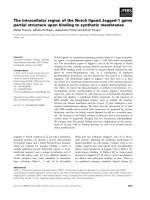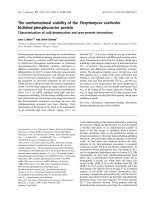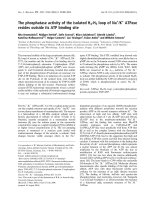Báo cáo khoa học: "The first report of Aelurostrongylus falciformis in Norwegian badgers (Meles meles)" pps
Bạn đang xem bản rút gọn của tài liệu. Xem và tải ngay bản đầy đủ của tài liệu tại đây (670.13 KB, 4 trang )
BioMed Central
Page 1 of 4
(page number not for citation purposes)
Acta Veterinaria Scandinavica
Open Access
Brief communication
The first report of Aelurostrongylus falciformis in Norwegian badgers
(Meles meles)
Rebecca K Davidson*
1
, Kjell Handeland
1
and Bjørn Gjerde
2
Address:
1
Section for Wildlife Diseases, National Veterinary Institute, P.O. Box 8156 Dep., NO-0033 Oslo, Norway and
2
Parasitology Laboratory,
Section for Microbiology, Immunology and Parasitology, Institute for Food Safety and Infection Biology, Norwegian School of Veterinary Science,
P.O. Box 8146 Dep., NO-0033 Oslo, Norway
Email: Rebecca K Davidson* - ; Kjell Handeland - ;
Bjørn Gjerde -
* Corresponding author
Abstract
The first report of Aelurostrongylus falciformis (Schlegel 1933) in Fennoscandian badgers is described.
Routine parasitological examination of nine Norwegian badgers, at the National Veterinary
Institute during 2004 and 2005, identified A. falciformis in the terminal airways of five of the animals.
The first stage larvae (L1) closely resembled, in size and morphology, those of Angiostrongylus
vasorum (Baillet 1866). The diagnosis for both A. falciformis and A. vasorum is frequently based on the
identification of L1 in faeces or sputum. The potential for misclassification of an A. falciformis
infection as A. vasorum, where larval identification is the only diagnostic method used, is discussed.
Background
Aelurostrongylus falciformis (Schlegel 1933) is a metastrong-
yle lung nematode of European badgers (Meles meles) and
has been reported in continental Europe [1,2] and Great
Britain [3] but not Fennoscandia. Other lung nematodes
seen in European badgers include the metastrongyles
Angiostrongylus vasorum (Baillet 1866) [4,5], Crenosoma sp.
(Molin 1861) [1-4], Aelurostrongylus pridhami (Anderson
1962) [5], as well as the trichuroid nematode Capillaria
aerophila (Creplin 1839) [2]. A. vasorum is considered to be
absent from the Scandinavian Peninsula. However,
recently it has been found on the island of Sydkoster off
the south west coast of Sweden [6] close to the Norwegian
border. This parasite has its predilection site in the pulmo-
nary artery and right ventricle of the heart. The diagnosis
however, as for A. falciformis, is frequently based on the
identification of first stage larvae (L1) in faeces or sputum
[7]. Crenosoma sp. and Capillaria aerophila infections can
be differentiated from those of A. vasorum and A. falci-
formis on the basis of their typical L1 (Crenosoma sp.) and
eggs (Capillaria aerophila).
Nine badgers from the Oslo and Akershus regions were
sent to the National Veterinary Institute, Oslo, during
2004 and 2005 (Table 1). Routine post-mortem was car-
ried out and revealed trauma as the cause of death in
seven of the animals whereas two had been shot for
humane reasons. Parasitological examination of the respi-
ratory tract, cardiovascular system and faeces was also car-
ried out.
The trachea and bronchi were dissected; two scrapes from
the mucous membrane were taken and examined for
nematode eggs and larvae. Biopsies, from each lung lobe,
were fixed in 10% formalin and embedded in paraffin.
They were then cut at 5µm and stained with haematoxylin
and eosin for histological examination. The right side of
the heart was incised and this incision extended along the
Published: 13 June 2006
Acta Veterinaria Scandinavica 2006, 48:6 doi:10.1186/1751-0147-48-6
Received: 02 May 2006
Accepted: 13 June 2006
This article is available from: />© 2006 Davidson et al; licensee BioMed Central Ltd.
This is an Open Access article distributed under the terms of the Creative Commons Attribution License ( />),
which permits unrestricted use, distribution, and reproduction in any medium, provided the original work is properly cited.
Acta Veterinaria Scandinavica 2006, 48:6 />Page 2 of 4
(page number not for citation purposes)
pulmonary artery to look for adult A. vasorum. At least two
10 gram faecal samples per animal, from some of the
badgers, were set up in Baermann apparatus for 6 hours
and then examined for faecal larval burden, larvae per
gram (lpg); the larvae collected were stored in 70% etha-
nol. Larvae from the respiratory tract and faeces were
examined under magnification, those with a wavy tail
were digitally photographed: length and width measure-
ments were taken (Leica Image Manager IM50 Measure-
ment Module, Version 4.0, Release 106). The width was
measured at the widest point.
Nematode larvae with a curvy tail and a notch, suggestive
of A. vasorum infection, were found for the first time in
bronchial scrapes. A more advanced examination of the
lungs in badger 1 was carried out. The lungs were dis-
sected to bronchiolar level and any adult nematodes were
carefully removed and placed in 70% ethanol. Larvae
were extracted from the uterus of an adult female and
compared to those found in the respiratory tract and fae-
ces. The adult nematodes and larvae were examined under
magnification, digitally photographed and measured. All
adult nematodes fragmented during extraction, and their
overall length could not be measured. Width measure-
ments were taken just anterior to the spicules in the males
and level with the uterus in the females. The length of the
male spicules and accessory spicules were recorded.
A. falciformis was found in five badgers and three had
Crenosoma melesi infections. Two of the badgers were
simultaneously infected with both parasites. Histological
examination confirmed the location of A. falciformis
within the terminal airways (Figure 1). Width measure-
ments of adult male and female nematodes, as well as the
length of the male spicules (Figure 2) and accessory spi-
Posterior end of a male Aelurostrongylus falciformis found in the lungs of a Norwegian badgerFigure 2
Posterior end of a male Aelurostrongylus falciformis found in
the lungs of a Norwegian badger. Evident are the spicules,
the accessory chinitous piece and the small bursa (Leica MPS
60 Camera). Bar = 50µm.
Table 1: Information regarding the nine badgers (Meles meles) submitted to the National Veterinary Institute, Oslo during the course
of 2004 and 2005 for post-mortem examination and examined for lung worms.
Badger ID Sex Age Cause of death Municipality of origin Aelurostrongylus falciformis(lpg) Crenosoma melesi(lpg)
1 female adult trauma Vestby positive (7) positive (0.3)
2 female adult trauma Oslo negative negative
3 male adult trauma Vestby negative positive
a
4 female adult trauma Oslo negative negative
5 male adult trauma Vestby positive (49) positive (11)
6 unknown adult trauma Vestby negative negative
7 female adult shot Grue positive (460) negative
8 male juvenile shot Vestby positive
a
negative
9 male adult trauma Vestby positive
a
negative
a
Baermannisation of the faeces not carried out, diagnosis based on the presence of larvae in bronchial scrapes.
Cross-sections of adult Aelurostrongylus falciformis in the ter-minal airways of a Norwegian badger (Leica DC300 Digital Camera)Figure 1
Cross-sections of adult Aelurostrongylus falciformis in the ter-
minal airways of a Norwegian badger (Leica DC300 Digital
Camera). Bar = 100µm.
Acta Veterinaria Scandinavica 2006, 48:6 />Page 3 of 4
(page number not for citation purposes)
cule are given in Table 2, which also shows reference val-
ues given in the literature for A. falciformis and A. vasorum.
No A. vasorum was found during the dissection of the
heart and pulmonary artery.
Larval burden varied considerably between the positive
animals (Table 1). Morphologically, the larvae appeared
identical to those obtained from an adult female. The
length and width of the isolated L1 were within the refer-
ence range given for A. falciformis (Table 2). The larvae
had a wavy tail with a notch (Figure 3a) and the anterior
end of the larvae had what could be interpreted as a
cephalic button (Figure 3b) resembling the L1 of A. vaso-
rum [6,7]. The parasite was identified as A. falciformis
given the location of the adult nematodes in the lung tis-
sue, the length of the male spicules, the presence of an
accessory spicule, and the size and morphology of the lar-
vae [8,9].
The present study is believed to be the first report of A. fal-
ciformis infection in Fenno-Scandinavian badgers. The L1
length was within the published reference range for A. fal-
ciformis, which overlaps the published L1 range for A. vaso-
rum. A. vasorum can be found in ectopic locations [10], but
the male nematodes, from the reported badger's lungs,
had short spicules and an accessory chitinous piece,
excluding A. vasorum from the differential list. Neverthe-
less, the great similarity between the L1 stages of A. falci-
formis and A. vasorum, in size and general morphology,
needs to be considered.
The prevalence of A. falciformis found in European badg-
ers, as well as the diagnostic criteria underlying the diag-
nosis, varies considerably between studies and needs
further investigation. Magi et al. (1999) [1] identified
adult A. falciformis and L1 in the lungs of 10 of 19 (53%)
Italian badgers. In a British study of 118 badgers for tuber-
culosis, A. falciformis was recorded incidentally in one ani-
mal [3]. In Spain, Millán et al. (2004) [4] reported A.
vasorum larvae in the faeces of 24 of 26 (92%) badgers;
however, they were unable to find adult nematodes in the
pulmonary artery or the right ventricle of the heart.
Another Spanish badger study [5] reported the presence of
both A. vasorum and A. pridhami, the latter is a parasite of
wild mink in North America [11], without describing the
identification methods used. It may be possible that an
infection with A. falciformis, particularly in areas where A.
vasorum is endemic, could be misinterpreted as A. vasorum,
Table 2: Several dimensions of adults and larvae of Aelurostrongylus falciformis as found in Norwegian badgers (with the median value
given in brackets), as well as analogous dimensions of A. falciformis and Angiostrongylus vasorum according to reference literature.
Dimensions Aelurostrongylus falciformis – Norwegian
badgers
Aelurostrongylus falciformis
[8;9;12]
Angiostrongylus vasorum
[7;13]
Male width (µm) 48 – 81.5 (69) 50 170 – 235
Female width (µm) 84.5 – 148.5 (105) 60 – 172 220 – 306
length (µm) 95 – 133 (100) 80 400 – 500
Accessory spicule length (µm) 39 – 52.5 (46) 40 Not applicable
L1 larval length (µm) 213 – 353 (248) 220 – 370 310 – 399
L1 larval width (µm) 9 – 19 (14) 15 – 17 13 – 17
The tail (a) and anterior end (b) of the L1 larvae found in a Norwegian badger infected with Aelurostrongylus falciformisFigure 3
The tail (a) and anterior end (b) of the L1 larvae found in a
Norwegian badger infected with Aelurostrongylus falciformis.
(Leica MPS 60 Camera; a – phase contrast; b – bright field).
Bar = 25µm.
Publish with BioMed Central and every
scientist can read your work free of charge
"BioMed Central will be the most significant development for
disseminating the results of biomedical research in our lifetime."
Sir Paul Nurse, Cancer Research UK
Your research papers will be:
available free of charge to the entire biomedical community
peer reviewed and published immediately upon acceptance
cited in PubMed and archived on PubMed Central
yours — you keep the copyright
Submit your manuscript here:
/>BioMedcentral
Acta Veterinaria Scandinavica 2006, 48:6 />Page 4 of 4
(page number not for citation purposes)
when larval identification is the only diagnostic method
used.
References
1. Magi M, Banchi C, Barchetti A, Guberti V: The parasites of the
badger (Meles meles) in the north of Mugello (Florence,
Italy). Parassitologia 1999, 41:533-536.
2. Stubbe M: Zur Biologie der Raubtiere eines abgeschlossenen
Waldgebietes (The biology of predators in a self-contained
woodland area). Zeitschrift für Jagdwissenschaft 1965, 11:73-102.
3. Jones GW, Neal C, Harris EA: The helminth parasites of the
badger (Meles meles) in Cornwall. Mammal Review 1980,
10:163-164.
4. Millán J, Sevilla I, Gerrikagoitia X, García-Pérez AL, Barral M:
Helminth parasites of the Eurasian badger (Meles meles L.)
in the Basque Country (Spain). European Journal of Wildlife
Research 2004, 50:37-40.
5. Torres J, Miquel J, Motjé M: Helminth parasites of the eurasian
badger (Meles meles L.) in Spain: a biogeographic approach.
Parasitology Research 2001, 87:259-263.
6. Åblad B, Christensson D, Osterman-Lind E, Ågren E, Mörner T:
Angiostrongylus vasorum etablerad i Sverige (Angiostrong-
ylus vasorum established in Sweden). Svensk Veterinärtidning
2003, 12:11-15.
7. Bolt G, Monrad J, Koch J, Jensen AL: Canine angiostrongylosis: a
review. The Veterinary Record 1994:447-452.
8. Schlegel M: Die Lungenwurmseuche beim Dachs (The lung-
worm epidemic in the badger). Berliner Tierärtzliche Wochen-
schrift 1934, 22:369-373.
9. Wetzel R: Zur Entwicklung des Dachslungenwurmes Filar-
oides falciformis (Schlegel1933) (The development of the
badger lungworm Filaroides falciformis (Schlegel 1933)). Sit-
zungsberichte der Gesellschaft Naturforschender Freunde zu Berlin Nr 1-3,
1-3 1937, 1-3:1-3.
10. Oliveira-Júnior SD, Barçante JMP, Barçante TA, Ribeiro VM, Lima WS:
Ectopic location of adult worms and first-stage larvae of
Angiostrongylus vasorum in an infected dog. Veterinary Parasi-
tology 2004, 121:293-296.
11. Anderson RC: Nematode Parasites of Vertebrates: Their Development
and Transmission 2nd Edition edition. CABI Publishing; 2000:162-165.
12. Wetzel R: Zur Biologie und systematischen Stellung des
Dachslungenwurmes (The biology and taxonomy of badger
lungworms). Livro Jubilar Do Professor Lauro Travassos 1938:531-537.
13. Guilhon J, Cens B: Angiostrongylus vasorum (Baillet 1866)
Etude biologique et morphologique (Angiostrongylus vaso-
rum (Baillet 1866) a biological and morphological study).
Annales de Parasitologie (Paris) 1973, 48:567-596.









